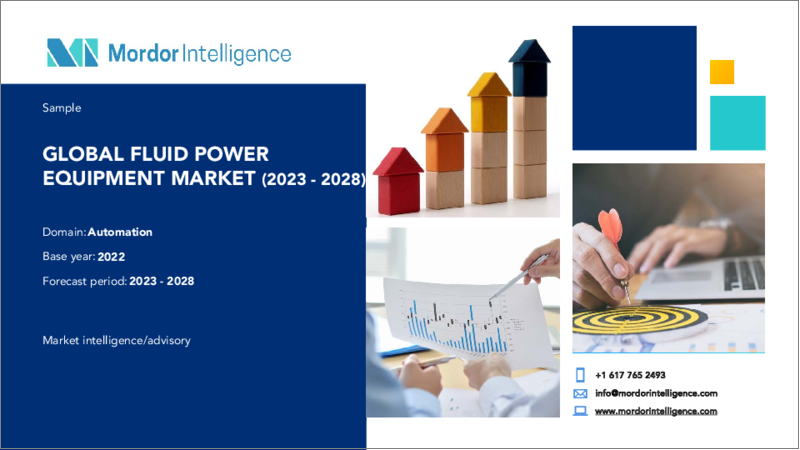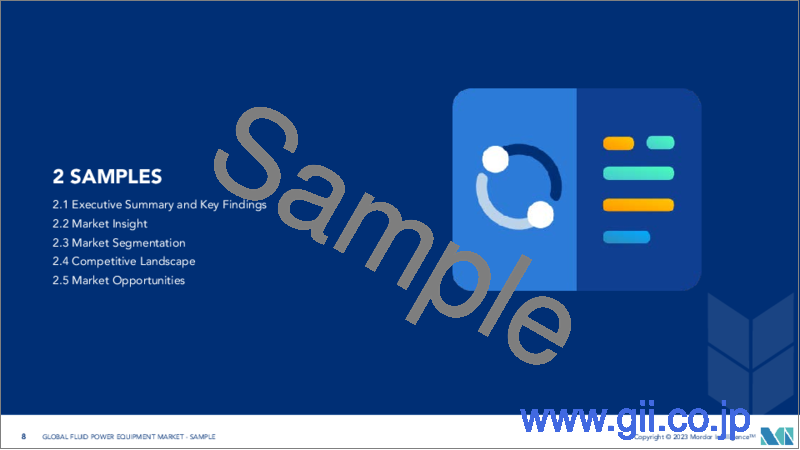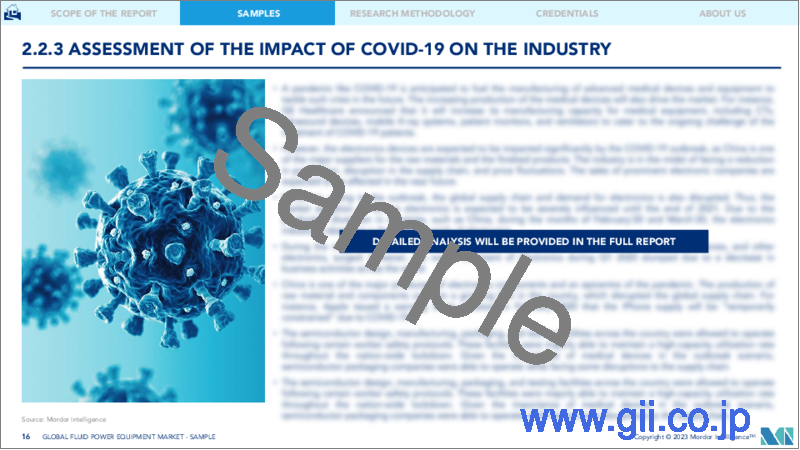|
|
市場調査レポート
商品コード
1190901
フルードパワー機器市場- 成長、動向、予測(2023年-2028年)Fluid Power Equipment Market - Growth, Trends, and Forecasts (2023 - 2028) |
||||||
|
● お客様のご希望に応じて、既存データの加工や未掲載情報(例:国別セグメント)の追加などの対応が可能です。 詳細はお問い合わせください。 |
|||||||
| フルードパワー機器市場- 成長、動向、予測(2023年-2028年) |
|
出版日: 2023年01月18日
発行: Mordor Intelligence
ページ情報: 英文 120 Pages
納期: 2~3営業日
|
- 全表示
- 概要
- 目次
油圧機器市場は、予測期間中にCAGR5.9%で成長すると予想されています。
この業界では、企業がよりインテリジェントな環境を目指す中で、自動化のラインにおける著しい発展が見られます。この市場で活動するいくつかの主要な利害関係者は、油圧製品と電気部門との間に相乗効果を生み出すことに賭けています。現在の市場における油圧技術の進歩には、液体動力伝達、モバイル診断ツール、ホース選択の簡素化、熱可塑性コンポーネント、電気油圧制御などがあります。
主なハイライト
- ベンダーは、高い修理費と交換費用を避けるために、油圧機器の定期的なメンテナンスを強く推奨しています。さらに、完全な修理はより長い期間、生産性を損なう可能性があるのに対し、機器の清掃や点検は数分、数時間のイベント交換で済むため、メンテナンスによって操業停止時間の短縮が保証されます。
- 例えば、2021年4月、REHOBOT Hydraulicsは電動油圧ポンプPME70-2500MRV/VR70の発売を発表しました。このポンプにはメンテナンス性の高いインダクションモータが組み込まれており、多くのアプリケーション産業における多くのお客様のニーズに応えられるように設計されています。
- 世界のインダストリー4.0の波は、スマートでインテリジェントなシステムに焦点を当てたパラダイムシフトで、コネクテッド油圧機器の成長を後押ししています。特に欧州では、機械メーカーが機械のデジタル化を進めています。ネットワーク化により、他の機械とのシームレスな統合のために、油圧機器の接続システムの進歩が促進されると予想されます。このことは、アナログの油圧機器からデジタル化された油圧技術への移行という動向に注目することができます。
- 食品加工と包装、自動車、マテリアルハンドリングと組み立て、化学/プラスチック/石油など、いくつかのエンドユーザー垂直市場における製造プロセスの自動化の出現は、空圧機器の採用に直接影響を与えました。さらに、省力化装置、自動機械、自動制御システムの進化も空気圧機器の使用を増加させました。
- 空圧機器の採用が進む背景には、空圧機器の持つ高いエネルギー効率へのニーズがあります。さらに、各社は空圧機器の設計に柔軟性を持たせることに注力しています。例えば、空気圧アクチュエーターは、オンラインサイジングソフトウェアやシリンダー設定ツールを使って、必要な力、圧力、機械的な制約を考慮して用途に合ったサイズに設定されます。
- また、市場の動向として、装置の小型化・軽量化のために、ポンプ流量に対する流体量の割合が減少していることが挙げられます。移動式油圧機器では、流体量が少ないため、サンプに滞留する時間が短くなります。これは冷却時間の短縮と空気の巻き込みの排除につながります。
- COVID-19の大流行により、油圧機器の製造に大きなサプライチェーンの混乱が生じました。製造業者は全国的な封鎖により工場の閉鎖を余儀なくされ、需給サイクルのギャップが生じました。全米フルードパワー協会は、パンデミックによる企業への影響を詳述し、信じられないほどの打撃を受けた企業がある一方で、回復力を示すことができた企業もあったとしています。経済衰退とロックダウンの課題に加え、調査した市場では、COVID-19パンデミックの間、重負荷マテリアルハンドリングを扱う油圧機器の主要動向として、カスタマイズの台頭を確認しました。
主な市場動向
バルブが市場で大きなシェアを占める
- 空圧バルブには、メカニカルバルブ、マニュアルバルブ、ソレノイドパイロット式、エアパイロット式、バキュームパイロット式などがあります。圧縮空気の力に大きく依存して動力を伝達する空気圧システムは、空気圧で作動する電動工具からディーゼルエンジンまで、いくつかの産業用途で実質的に見られるため、複数の用途で使用されるようになりました。
- さらに、2021年には、米国に拠点を置くコントロールバルブと特殊流体処理製品のメーカーであるWarren Controls社が、電動式工業用グローブコントロールバルブのILEA 2900Eシリーズを発売しました。このシリーズは、高品質なモジュレーティング、リニア、工業用電動バルブアクチュエータを搭載し、様々なトリム素材を使用した頑丈な鋳鉄製ボディを特徴としています。2900Eシリーズは、廃水を含むアプリケーションにおいて、価値と長寿命が重要な目的である場合に適しています。
- また、圧力開放弁は、一般的に圧力を大気中に排出することによって、その入口ポートに存在する圧力を制御します。リリーフバルブは通常、レシーバやアキュムレータのような空気貯蔵装置にのみ利用され、過剰な加圧を防ぐために利用されます。また、その他の空気圧システムには、流量を制御するためのバルブがあります。空気圧方向制御弁は、複数のスタイル、サイズ、構成で提供されており、一方向への自由な流れを可能にし、逆方向の流れを防止します。また、ユーロスタットによると、イタリアにおけるその他のタップやバルブの生産による収益は、2025年までに約105億2000万米ドルになると予想されており、これが市場の成長をさらに後押しすることになるでしょう。
- 2021年9月、Linde Hydraulics GmbH &Co.KGは、次世代コントロールバルブを発表しました。開放回路用の新しいバルブブロックVW 22/18 M5-03は、モジュラーシステムが特徴で、5つのセクションと圧力解放セクションを備えたMonoblockが基本セットアップを表します。オプションとして、ブロックの両側に3つのセクションを追加することができ、お客様のニーズに対応します。
- さらに、ボッシュ・レックスロスは2021年にプリコンペンセーション・バルブ・プラットフォームを発表し、モバイル機器メーカーがさまざまな油圧制御バルブを選択的に組み合わせて、特定の運転要件や性能要件に適合する単一の統合型多機能制御ソリューションにすることが容易になりました。
- インダストリー4.0は、自動化技術の進歩により、操作と安全性をよりよく制御するためのスマートバルブの利用が急速に拡大しています。また、水需要の増加や人口の増加により、水の供給量が減少しているにもかかわらず、一人当たりの水の消費量は年々増加しています。
北米が著しい成長を遂げる見込み
- 北米では、さまざまな産業で製造や研究開発が盛んに行われているため、高い市場シェアを獲得しています。さらに、化学や石油・ガスなどの産業において、労働者の安全を確保するための取り組みが増加していることも、同地域の市場成長を後押ししています。
- 石油・ガス業界では、油圧システムは流体の圧力を利用してポンプを駆動させます。これは、通常約2,000~5,000psiの超高圧用に設計された3連ポンプを使用して、流体を坑内に送り込むことによって行われます。一般に、油圧リフトは機械式リフトポンプよりも生産量が多いです。EIAによると、米国の天然ガス消費量は2021年に平均825億立方フィート/日(Bcf/d)、2022年には838億立方フィート/日になると予想されています。消費量の増加に伴い、市場は潜在的な成長に対応します。
- さらに、建設業界における油圧機器の需要増が、市場の成長を後押ししています。例えば、2021年4月、Kobelco Construction Machinery USAは、北米における掘削機およびクレーンの生産について、ヤンマーおよびいすゞとエンジン供給契約を締結したと発表しました。
- さらに、2021年5月には、日立建機が北米で、すべてのアクチュエータの最適流量を調整することで複合作業を可能にする「日立トリプルH油圧システム」を採用したショベルカー「ZX50U」を発売しました。また、2022年8月には、北米ボルボが電動式建設機械2台を導入し、北米での電動式建設機械のラインアップを拡充しました。この機械は、電気モーターと油圧ポンプを連動させることで走行します。こうした技術革新は、同地域における油圧機器の採用をさらに後押ししています。
- 米国エネルギー省によると、米国の製造業では、圧縮空気システムが総電力の10%、モーターシステムの総エネルギーの約16%を使用しているとのことです。さらに、圧縮空気システムは、米国の全製造工場の70%で使用されていると述べています。これらのシステムの大部分は、工作機械、塗装ブース、材料分離、マテリアルハンドリングなど、工場内のさまざまな機器に電力を供給するために圧縮空気を供給しています。
- さらに、米国では食品安全近代化法の一環として新しいFDAガイドラインが制定され、厳しい消毒と衛生要件が要求されるようになりました。その結果、サプライヤーや包装業者は、適切な機器洗浄のニーズを満たすことを余儀なくされるでしょう。空気圧機器は、油圧機器やその他の機械機器よりも清潔であるため、食品加工業界のさまざまな用途に使用することができます。このような法律により、この地域の市場は急速に繁栄することができるのです。
競合情勢
フルードパワー機器市場は、Bosch-Rexroth AG、Danfoss AS、Eaton Corporation、Festo AG、SMC Corporation、Emerson Electric Co.、Schlumberger Limitedといった少数の主要企業により、適度に集約化されています。各社は、より多くの市場シェアを獲得するために、戦略的パートナーシップと製品開拓に継続的に投資しています。
その他の特典
- エクセル形式の市場予測(ME)シート
- アナリストによる3ヶ月間のサポート
目次
第1章 イントロダクション
- 調査の前提条件と市場の定義
- 調査対象範囲
第2章 調査手法
第3章 エグゼクティブサマリー
第4章 油圧機器の世界市場展望
- 現在の市場シナリオ
- 主要な市場促進要因・課題
第5章 市場のセグメンテーション- 油圧機器の世界市場
- 製品タイプ別
- ポンプ
- モーター
- バルブ
- シリンダー
- アキュムレータ・フィルタ
- その他製品タイプ(トランスミッション、液体用コネクターなど)
- 業界別
- 建設機械
- 農業用
- マテリアルハンドリング
- 石油・ガス分野
- 航空宇宙・防衛
- 工作機械
- 油圧機器
- その他業界別
- 地域別情報
- 北米
- 欧州
- アジア太平洋地域
- 世界のその他の地域
- ベンダー別市場シェア分析- 油圧機器市場
第6章 競合情勢
- 企業プロファイル
- Bosch-Rexroth AG
- Danfoss AS
- Eaton Corporation
- Hydac
- Parker-Hannifin Corporation
- HydraForce Inc.
- Kawasaki Heavy Industries Limited
- Nachi-Fujikoshi Corp.
- 市場の展望 油圧機器市場
第7章 空圧機器の世界市場展望
- 現在の市場シナリオ
- 市場の主要な促進要因・課題
第8章 市場セグメンテーション:空圧機器の世界市場
- 製品タイプ別
- バルブ
- アクチュエーター
- FRLs
- フィッティング
- その他の製品タイプ
- 業界別
- 食品加工・包装
- 自動車関連
- マテリアルハンドリングと組み立て
- 化学・プラスチック・石油
- 半導体・電子部品
- 金属加工
- 紙・印刷
- ライフサイエンス
- その他業界別
- 地域別情報
- 北米
- 欧州
- アジア太平洋地域
- 世界のその他の地域
- ベンダーの市場シェア分析- 空気圧機器市場
第9章 競合情勢
- 企業プロファイル
- Festo AG
- SMC Corporation
- Emerson Electric Co.
- Schlumberger Limited
- IMI Precision Engineering
- Parker Hannifin Corporation
- Ingersoll Rand Inc.
- Flowserve BV(Flowserve Corporation)
- Neles Oyj
- 市場の展望- 空気圧機器市場
The hydraulic equipment market is expected to grow at a CAGR of 5.9% over the forecast period. The industry is witnessing significant development in the lines of automation as companies move towards a more intelligent environment. Several key stakeholders operating in the market are banking upon creating a synergy between the hydraulic products and the electrical division. Advancements in hydraulic technology in the current market include liquid power transmission, mobile diagnostic tools, simplified hose selection, thermoplastic components, and electrohydraulic control.
Key Highlights
- Vendors highly stress the regular maintenance of hydraulic equipment to avoid high repair and replacement costs. Furthermore, maintenance ensures the reduction of downtime for operations as cleaning and checking the equipment can be a matter of minutes, replacement an event of hours, whereas complete repair could suffer productivity by a more extended period.
- For instance, in April 2021, REHOBOT Hydraulics announced the launch of the PME70-2500MRV/VR70, an electric-powered hydraulic pump. This pump is incorporated with a low-maintenance induction motor, and it is designed to meet the needs of many clients in many application industries.
- The wave of Industry 4.0 across the globe is boosting the growth of connected hydraulic equipment with a paradigm shift of focus on smart and intelligent systems. Machine manufacturers, especially in Europe, are digitalizing the machines. The networking is expected to facilitate the advancement of connected systems in the hydraulic equipment for seamless integration with other machines. This can be noted in the trend of moving from analog hydraulic equipment to digitized hydraulic technology.
- The advent of automation in manufacturing processes in several end-user verticals, including Food Processing and Packaging, Automotive, Material Handling and Assembly, and Chemicals/Plastics/Oil, directly impacted the adoption of pneumatic equipment. Further, the evolution of labor-saving devices, automatic machinery, and automatic-control systems directed an increase in the use of pneumatics.
- The trend of adopting pneumatic equipment for various operations is facilitated by the need for high energy efficiency that is offered by this equipment. Furthermore, companies are focusing on providing flexibility in the design of pneumatic equipment. For instance, pneumatic actuators are sized to the application considering the necessary force, pressure, and mechanical limitations through online sizing software and cylinder configuration tools.
- Another trend that has gained traction in the market studied is reduced fluid volumes relative to pump flow rates for smaller and lighter equipment. The lower fluid volume in mobile hydraulic equipment allows less time in the sump. This translates to less time for cooling and the elimination of entrained air.
- The COVID-19 pandemic created significant supply chain disruptions for the manufacturing of hydraulic power equipment. Manufacturers were forced to shut down factories due to the nationwide lockdown, which created a supply and demand cycle gap. The National Fluid Power Association detailed the pandemic's impact on companies, with a few of them being incredibly hit while others being able to show resilience. In addition to economic decline and lockdown challenges, the market studied has seen the rise of customization as a key trend in hydraulic equipment dealing with heavy-load material handling during the COVID-19 pandemic.
Key Market Trends
Valves Holds a Significant Share in the Market
- Pneumatic valves include mechanical valves, manual valves, solenoid-piloted, air piloted, and vacuum-piloted. Pneumatic systems that considerably depend on the force of compressed air to transmit power are substantially found in several industrial applications, from pneumatically operated power tools to diesel engines, thus, driving their usage in multiple applications.
- Further, in 2021, a US-based manufacturer of control valves and specialty fluid handling products, Warren Controls, launched its ILEA 2900E series of electrically actuated industrial globe-control valves. The series hosts a high-quality, modulating, linear, industrial electric valve actuator while featuring a rugged cast-iron body with various trim materials. The 2900E series is suited where value and long life are important objectives for applications, including wastewater.
- Furthermore, pressure relief valves generally control pressure present at their inlet port by exhausting pressure to the atmosphere. Relief valves are typically utilized only in receivers or air storage devices, such as accumulators, to prevent excessive pressurization. Also, other pneumatic systems are valves to control flow. Pneumatic directional valves are offered in multiple styles, sizes, and configurations, which allows free flow in one direction and prevents flow in the reverse direction. In addition, according to Eurostat, the revenue from the production of other taps and valves in Italy is expected to be around USD 10.52 billion by 2025, which will further drive the market's growth.
- In September 2021, Linde Hydraulics GmbH & Co. KG introduced its next generation of control valves. The new valve block VW 22/18 M5-03 for the open circuit is characterized by its modular system, whereby the Monoblock with five sections plus a pressure relief section represents the basic set-up. Optionally, three additional sections can be added on each side of the block, thus specifically addressing customer needs.
- Moreover, in 2021, Bosch Rexroth launched a pre-compensated valve platform making it easier for mobile machine builders to selectively combine a range of hydraulic control valves into a single, integrated, multifunctional control solution to match specific operational and performance requirements.
- Industry 4.0 is being driven by advancements in automation technologies, which are resulting in rapid growth in the usage of smart valves to gain better control over operation and safety. Furthermore, rising water demand, together with an increase in population resulted in greater water consumption per capita over time, despite decreased water supply.
North America to Witness Considerable Growth
- Due to the growing development in manufacturing and R&D activities in various industries across North America, the region holds a high market share. Furthermore, the rising number of initiatives taken to ensure the safety of the workers in industries, such as chemicals and oil and gas also support the market growth in the region.
- In oil and gas, hydraulic systems use fluid pressure to power a pump. That is done by pumping fluids downhole using a triplex pump designed for extremely high pressure, usually between approximately 2,000 and 5,000 psi. In general, hydraulic lifts have higher production volumes than mechanical lift pumps. According to EIA, it is expected that the US consumption of natural gas will average 82.5 billion cubic feet per day (Bcf/d) in 2021 and 83.8 Bcf/d in 2022. With increasing consumption, the market caters to potential growth.
- Furthermore, the increasing demand for hydraulic equipment in the construction industry is driving the market's growth. For instance, in April 2021, Kobelco Construction Machinery USA announced that the company had secured an engine supply agreement with Yanmarand Isuzu for the production of excavators and cranes in North America.
- Moreover, in May 2021, Hitachi Construction Machinery introduced a ZX50U excavator in North America, which uses the Hitachi triple H hydraulic system, which enables combined operations by adjusting the optimal flow rate for all actuators. In addition, in August 2022, Volvo North America introduced two electric construction machines to expand its electric construction line in North America. The machine runs by engaging the electric motors with hydraulic pumps. Such innovations are further driving the adoption of hydraulic equipment in the region.
- According to the US Department of Energy, compressed air systems use 10% of total power and around 16% of total motor system energy in US manufacturing businesses. It further states that compressed air systems are used in 70% of all manufacturing plants in the United States. The majority of these systems deliver compressed air to power a range of equipment in a given plant, such as machine tools, painting booths, material separation, and materials handling.
- Furthermore, the new FDA guidelines in the United States were enacted as part of the Food Safety Modernization Act, which requires strict disinfection and hygiene requirements. As a result, suppliers and packagers will be compelled to meet their needs for proper equipment cleaning. Pneumatic equipment is cleaner than hydraulic and other mechanical equipment, allowing it to be used in a variety of applications in the food processing industry. Such laws enable the region's market to flourish rapidly.
Competitive Landscape
The fluid power equipment market is moderately consolidated, with a few significant companies like Bosch-Rexroth AG, Danfoss AS, Eaton Corporation, Festo AG, SMC Corporation, Emerson Electric Co., and Schlumberger Limited. The companies continuously invest in strategic partnerships and product developments to gain more market share.
In December 2021, Danfoss Power Solutions introduced a multi-axis steering for OEMs to improve the maneuverability and productivity of farm and construction equipment. The system enables tighter turns and high-visibility crabbing. The technology is rooted in a software-driven electro-hydraulic valve that allows on-the-go independent control of a vehicle's front and rear axles from the cab. The technology is used on tractors in European vineyards and on construction and material handling equipment in the European Union.
In May 2021, Bosch Rexroth launched a fast and power-dense Hagglunds Atom hydraulic motor. The Hagglunds Atom replaces the existing Hagglunds CAb, delivering not only more revolutions per minute, but also more powerful than motors of similar size. The result is a tiny, power-dense package that is ideal for mobile, marine, and recycling applications.
Additional Benefits:
- The market estimate (ME) sheet in Excel format
- 3 months of analyst support
TABLE OF CONTENTS
1 INTRODUCTION
- 1.1 Study Assumptions and Market Definition
- 1.2 Scope of the Study
2 RESEARCH METHODOLOGY
3 EXECUTIVE SUMMARY
4 GLOBAL HYDRAULIC EQUIPMENT MARKET OUTLOOK
- 4.1 Current Market Scenario
- 4.2 Key Market Influencers - Market Drivers and Challenges
5 MARKET SEGMENTATION - GLOBAL HYDRAULIC EQUIPMENT MARKET
- 5.1 By Product Type
- 5.1.1 Pumps
- 5.1.2 Motors
- 5.1.3 Valves
- 5.1.4 Cylinders
- 5.1.5 Accumulators and Filters
- 5.1.6 Other Product Types (Transmission, Fluid Connectors, etc.)
- 5.2 By End-user Vertical
- 5.2.1 Construction
- 5.2.2 Agriculture
- 5.2.3 Material Handling
- 5.2.4 Oil and Gas
- 5.2.5 Aerospace and Defense
- 5.2.6 Machine Tools
- 5.2.7 Hydraulic Tools
- 5.2.8 Other End-user Verticals
- 5.3 By Geography
- 5.3.1 North America
- 5.3.2 Europe
- 5.3.3 Asia-Pacific
- 5.3.4 Rest of the World
- 5.4 Vendor Market Share Analysis - Hydraulic Equipment Market
6 COMPETITIVE LANDSCAPE
- 6.1 Company Profiles
- 6.1.1 Bosch-Rexroth AG
- 6.1.2 Danfoss AS
- 6.1.3 Eaton Corporation
- 6.1.4 Hydac
- 6.1.5 Parker-Hannifin Corporation
- 6.1.6 HydraForce Inc.
- 6.1.7 Kawasaki Heavy Industries Limited
- 6.1.8 Nachi-Fujikoshi Corp.
- 6.2 Market Outlook - Hydraulic Equipment Market
7 GLOBAL PNEUMATIC EQUIPMENT MARKET OUTLOOK
- 7.1 Current Market Scenario
- 7.2 Key Market Influencers - Market Drivers and Challenges
8 MARKET SEGMENTATION - GLOBAL PNEUMATIC EQUIPMENT MARKET
- 8.1 By Product Type
- 8.1.1 Valves
- 8.1.2 Actuators
- 8.1.3 FRLs
- 8.1.4 Fittings
- 8.1.5 Other Product Types
- 8.2 By End-user Vertical
- 8.2.1 Food Processing and Packaging
- 8.2.2 Automotive
- 8.2.3 Material Handling and Assembly
- 8.2.4 Chemicals/Plastics/Oil
- 8.2.5 Semiconductor and Electronics
- 8.2.6 Metalworking
- 8.2.7 Paper and Printing
- 8.2.8 Life Sciences
- 8.2.9 Other End-user Verticals
- 8.3 By Geography
- 8.3.1 North America
- 8.3.2 Europe
- 8.3.3 Asia-Pacific
- 8.3.4 Rest of the World
- 8.4 Vendor Market Share Analysis - Pneumatic Equipment Market
9 COMPETITIVE LANDSCAPE
- 9.1 Company Profiles
- 9.1.1 Festo AG
- 9.1.2 SMC Corporation
- 9.1.3 Emerson Electric Co.
- 9.1.4 Schlumberger Limited
- 9.1.5 IMI Precision Engineering
- 9.1.6 Parker Hannifin Corporation
- 9.1.7 Ingersoll Rand Inc.
- 9.1.8 Flowserve BV (Flowserve Corporation)
- 9.1.9 Neles Oyj
- 9.2 Market Outlook - Pneumatic Equipment Market




